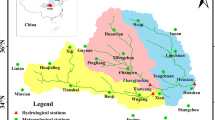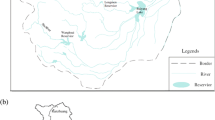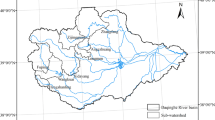Abstract
Recent evidences of the impact of regional climate variability, coupled with the intensification of human activities, have led hydrologists to study flood regime without applying the hypothesis of stationarity. In this study, identification of nonstationarity was conducted in the form of both trend and change point in the mean of the annual maximum flood magnitudes, using Mann-Kendall and Pettitt test, respectively in Wangkuai reservoir watershed, China. The annual maximum flood series exhibited a significant decreasing trend, and the timing of change point was detected in 1979, which was consistent with the construction of large numbers of check dams and small hydraulic structures. A correlation test (Pearson correlation test) between large-scale oceanic-atmospheric patterns (El Niño Southern Oscillation (ENSO), Pacific Decadal Oscillation (PDO), North Pacific Oscillation (NPO), North Atlantic Oscillation (NAO), Atlantic Oscillation (AO)) and annual maximum flood peaks was adopted to assess the climatic causes of nonstationary flood series. It was found that NPO, NAO and AO had significant correlations with flood peak, but ENSO and PDO could not explain the variations of flood peak. In the case of human-induced nonstationarity, we proposed 2 new indices to represent the effect of human activities on flood. The new indices were proposed based on the storage capacity and drainage area of the large numbers of check dams and small hydraulic structures which were estimated with no observed data. The identification of nonstationarity for flood series and the climatic and human-induced causes could provide useful information in nonstationary flood frequency analysis.






Similar content being viewed by others
References
Alvarez UFH, Trudel M, Leconte R (2014) Impacts and adaptation to climate change using a reservoir management tool to a northern watershed: application to Lievre river watershed, Quebec, Canada. Water Resour Manag 28:3667–3680
Azizabadi M, Khalili D (2013) Seasonality characteristics and spatio-temporal trends of 7-day low flows in a large, semi-arid watershed. Water Resour Manag 27:4897–4911
Brath A, Montanari A, Moretti G (2006) Assessing the effect on flood frequency of land use change via hydrological simulation (with uncertainty). J Hydrol 324:141–153
Burn DH, Hag EMA (2002) Detection of hydrologic trends and variability. J Hydrol 255:107–122
Casanueva A, Puebla CR, Frias MD et al (2014) Variability of extreme precipitation over Europe and its relationships with teleconnection patterns. Hydrol Earth Syst Sci 18:709–725
Collins MJ (2009) Evidence for changing flood risk in New England since the late 20th century. J Am Water Resour Assoc 45:279–290
El Aldouni S, Ouarda T, Zhang X et al (2007) Generalized maximum likelihood estimators for the nonstationary generalized extreme value model. Water Resour Res 43:1–13
Farazjoo BSH, Yazdandoost BBF (2008) Flood intensification due to changes in land use. Water Resour Manag 22:1051–1067
Fritsch CE (2012) Evaluation of flood risk in response to climate variability. Dissertation, Michigan Technological University
Gao Q, Huo L, Gong JX (2008) Trend analysis on flooding changes in Urumqi river. Desert and Oasis Meteorol 2:30–33
Gilroy KL, McCuen RH (2012) A nonstationary flood frequency analysis method to adjust for future climate change and urbanization. J Hydrol 414:40–48
Hirabayashi Y, Knae S, Emori S et al (2008) Global projections of changing risks of floods and droughts in a changing climate. Hydrol Sci J 53:754–772
Hodgkins G, Dudley R, Huntington T (2003) Changes in the timing of high river flows in New England over the 20th century. J Hydrol 278:244–252
Hollis GE (1975) The effect of urbanization on flood of different recurrence interval. Water Resour Res 11:431–435
Hu HY, Huang GR (2012) Variation trends of rainfall and flood in Dongtiaoxi basin. Water Power 38:14–17
IPCC (2012) Managing the risks of extreme events and disasters to advance climate change adaption. A special report of working groups I and II of the Intergovernmental Panel on Climate Change. Cambridge University Press, Cambridge
Jothityangkoon C, Hirunteeyakul C, Boonrawd K et al (2013) Assessing the impact of climate and land use changes on extreme floods in a large tropical catchment. J Hydrol 190:88–105
Kendall M (1975) Rank correlation measures. Charles Griffin, London
Khaliq MN, Ouarda TBMJ, Ondo JC et al (2006) Frequency analysis of a sequence of dependent and/or non-stationary hydro-meteorological observations: A review. J Hydrol 329:534–552
Kwon HH, Brown C, Lall U (2008) Climate informed flood frequency analysis and prediction in Montana using hierarchical Bayesian modeling. Geophys Res Lett 35, L050404
Li JZ, Feng P (2010) Effects of precipitation on flood variations in the Daqinghe river basin. J Hydraul Eng 41:595–600
Li JZ, Feng P, Chen FL (2014a) Effects of land use change on flood characteristics in mountainous area of Daqinghe watershed, China. Nat Hazards 70:593–607
Li JZ, Tan SM, Wei ZZ et al (2014b) A new method of change point detection using variable fuzzy sets under environmental change. Water Resour Manag 28:5125–5138
Lopez J, Frances F (2013) Non-stationary flood frequency analysis in continental Spanish rivers, using climate and reservoir indices as external covariates. Hydrol Earth Syst Sci 17:3189–3203
Mann HB (1945) Nonparametric tests against trend. Econometrica 13:245–259
McCormick BC, Eshleman KN, Griffith JL et al (2009) Detection of flooding responses at the river basin scale enhanced by land use change. Water Resour Res. doi:10.1029/2008WR007594
Milly PCD, Betancourt J, Falkenmark M et al (2008) Stationarity is dead: Whither water management? Science 319:573–574
Niehoff D, Fritsch U, Bronstert A (2002) Land-use impacts on storm runoff generation: scenarios of land-use change and simulation of hydrological response in a meso-scale catchment in SW-Germany. J Hydrol 267:80–93
Niu J, Chen J, Sivakumar B (2013) Teleconnection analysis of runoff and soil moisture over the Pearl river basin in South China. Hydrol Earth Syst Sci Discuss 10:11943–11982
Olsen JR, Stedinger JR, Matalas NC et al (1999) Climate variability and flood frequency estimation for the Upper Mississippi and Lower Missouri rivers. J Am Water Resour Assoc 35:1509–1523
Ouarda T, El Aldouni S (2011) Bayesian nonstationarity frequency analysis of hydrological variables. J Am Water Resour Assoc 47:496–505
Pettitt A (1979) A non-parametric approach to the change-point problem. Appl Stat 28:126–135
Piechota TC, Dracup JA (1999) Long-range streamflow forecasting using El Niño-Southern Oscillation indicators. J Hydrol Eng 4:144–151
Reeves J, Chen J, Wang XL et al (2007) A review and comparison of change point detection techniques for climate data. J Appl Meteorol Climatol 46:900–915
Saghafian B, Farazjoo H, Bozorgy B et al (2008) Flood intensification due to changes in land use. Water Resour Manag 22:1051–1067
Salvadori N (2013) Evaluation of non-stationarity in annual maximum flood series of moderately impaired watersheds in the upper Midwest and Northeastern United States. Dissertation, Michigan Technological University
Shadmani M, Marofi S, Roknian M (2012) Trend analysis in reference evapotranspiration using Mann-Kendall and Spearman’s Rho tests in arid regions of Iran. Water Resour Manag 26:211–224
Svensson C, Kundzewicz WZ, Maurer T (2005) Trend detection in river flow series: 2. Flood and low-flow index series. Hydrolog Sci J 50:811–824
Vasiliades L, Galiatsatou P, Loukas A (2014) Nonstationary frequency analysis of annual maximum rainfall using climate covariates. Water Resour Manag. doi:10.1007/s11269-014-0761-5
Villarini G, Serinaldi F, Smith JA et al (2009a) On the stationarity of annual flood peaks in the continental United States during the 20th century. Water Resour Res. doi:10.1029/2008WR007645
Villarini G, Smith JA (2010) Flood peak distributions for the eastern United States. Water Resour Res. doi:10.1029/2009WR008395
Villarini G, Smith JA, Serinaldi F et al (2009b) Flood frequency analysis for nonstationary annual peak records in an urban drainage basin. Adv Water Resour 32:1255–1266
Wang C, Zhou XP, Wang WS (2012) Comprehensive diagnosis of change point of flood series in Kuye river. Water Resour Power 30:50–53
Wang W, Van Gelder PHAJM, Vrijling JK (2005) Trend and stationarity analysis for streamflow processes of rivers in Western Europe in the 20th century. IWA International Conference on water economics, statistics, and finance, Rethymno, Greece, 8–10 July 2005.
Wang W, Vrijling JK, Van Gelder PHAJM et al (2006) Testing for nonlinearity of streamflow processes at different timescales. J Hydrol 322:247–268
Ward PJ, Eisner S, Florke M et al (2014) Annual flood sensitivities to El Niño-Southern Oscillation at global scale. Hydro Earth Syst Sci 18:47–66
Xie JH, Xie P, Xu B et al (2012) Analysis of multi-scale flood series alteration in the East river basin. J Water Resour Res 1:370–374
Xu YD, Fu BJ, He CS (2013) Assessing the hydrological effect of the check dams in the Loess Plateau, China, by model simulations. Hydrol Earth Syst Sci 17:2185–2193
Yilmaz AG, Perera BJC (2013) Extreme rainfall non-stationarity investigation and intensity-frequency-duration relationship. J Hydrol Eng. doi:10.1061/(ASCE)HE.1943-5584.0000878
Yoo SH (2007) Urban water consumption and regional economic growth: the case of Taejeon, Korea. Water Resour Manag 21:1353–1361
Zeng H, Feng P, Li X (2014) Reservoir flood routing considering the non-stationarity of flood series in North China. Water Resour Manag 28:4273–4287
Acknowledgments
This work was supported by National Natural Science Foundation of China (No. 51209157). We are also grateful to Hydrology and Water Resource Survey Bureau of Hebei Province for providing the hydrometeorological data.
Author information
Authors and Affiliations
Corresponding author
Rights and permissions
About this article
Cite this article
Li, J., Liu, X. & Chen, F. Evaluation of Nonstationarity in Annual Maximum Flood Series and the Associations with Large-scale Climate Patterns and Human Activities. Water Resour Manage 29, 1653–1668 (2015). https://doi.org/10.1007/s11269-014-0900-z
Received:
Accepted:
Published:
Issue Date:
DOI: https://doi.org/10.1007/s11269-014-0900-z




